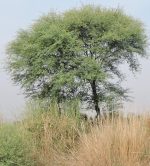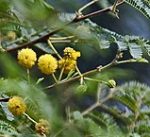 Also known as babul, thorn mimosa, Egyptian acacia and thorny acacia this evergreen flowering tree or shrub is native to Africa, the Middle East, and India where it is found in grasslands, woodlands, scrub, thickets, and along river banks the experience periodic flooding . It is a member of the pea family, Fabaceae, that also includes bean, lupine, and locust. The trees grow 16-66′ tall from a deep root system and have a dense spherical or flat crown, dark colored fissured bark, and axillary pairs of thin, straight gray spines 3″ long when young. The bipinnate leaves are divided into 3-6 pairs of leaflets that are further divided into 10-30 pairs of pinnulae. Glands may be located at the base of the leaf petiole and between the pinnulae. In summer, axillary globular heads of golden yellow flowers about 1/2″ across appear on 1″ long stems. The fruits are white-gray, hairy pods that are constricted around the 12 or less roundish enclosed seeds. The trees have been valued since ancient times for a variety of uses including herbal medicine and food. They have naturalized in the US and Australia, however, and become invasive weeds. Some authorities believe that this plant growing with a parasitic plant with red flowers may be the “burning bush” mentioned in the Bible, Exodus 3:2-4. The genus name Acacia is from the ancient Greek word ἄκις (ákis) meaning thorn. The specific epithet, nilotica, refers to the tree’s best-known range along the Nile river.
Also known as babul, thorn mimosa, Egyptian acacia and thorny acacia this evergreen flowering tree or shrub is native to Africa, the Middle East, and India where it is found in grasslands, woodlands, scrub, thickets, and along river banks the experience periodic flooding . It is a member of the pea family, Fabaceae, that also includes bean, lupine, and locust. The trees grow 16-66′ tall from a deep root system and have a dense spherical or flat crown, dark colored fissured bark, and axillary pairs of thin, straight gray spines 3″ long when young. The bipinnate leaves are divided into 3-6 pairs of leaflets that are further divided into 10-30 pairs of pinnulae. Glands may be located at the base of the leaf petiole and between the pinnulae. In summer, axillary globular heads of golden yellow flowers about 1/2″ across appear on 1″ long stems. The fruits are white-gray, hairy pods that are constricted around the 12 or less roundish enclosed seeds. The trees have been valued since ancient times for a variety of uses including herbal medicine and food. They have naturalized in the US and Australia, however, and become invasive weeds. Some authorities believe that this plant growing with a parasitic plant with red flowers may be the “burning bush” mentioned in the Bible, Exodus 3:2-4. The genus name Acacia is from the ancient Greek word ἄκις (ákis) meaning thorn. The specific epithet, nilotica, refers to the tree’s best-known range along the Nile river.
 Type: Evergreen flowering tree
Type: Evergreen flowering tree
Outstanding Feature: Gum
Form: Spherical or flat crown
Growth Rate: Rapid
Bloom: Axillary globular heads of golden yellow flowers about 1/2″ across on 1″ long stems in summer
Size:16-66′ H
Light: Full sun
Soil: Average, medium moist, well-drained; somewhat tolerant of drought and flooding.
Hardiness: Zones 10-12
Care: Low maintenance
Pests and Diseases: Wood borers, bruchids; Ctyospora acaciae, Diplodia acaciae, Fomes badius, F. endotheius, F. fastuosus, F. rimosus, Fusicoccum indicum, Phyllactinia acaciae, Ravenelia acaciae-arabicae,Septogloeum acaciae, Septoria mortolensis, Sphaerostilbe acaciae, Dendrophthoe falcata, Loranthus globiferus var. verrucosus
Propagation: Fresh seed or scarified seed
Photo Credits: Wikipedia